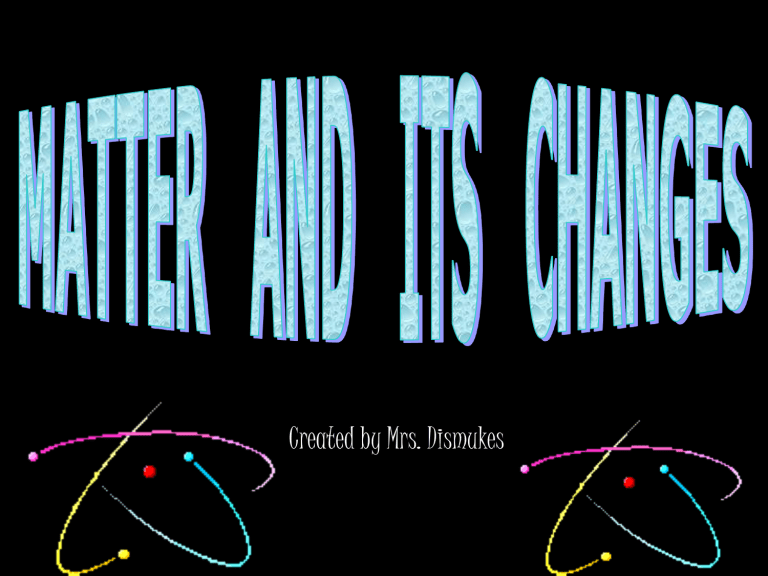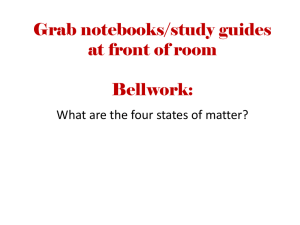What is Matter?

Created by Mrs. Dismukes
THE THREE STATES OF
MATTER
Vocabulary Words
Matter
Mass
Liquid
Solid
Gas
What is Matter?
MATTER IS THE STUFF
AROUND YOU
Not very clear, but it's true.
Anything that takes up space or has a mass of any kind is matter.
Everything you can touch is made of matter.
Mass is the amount of matter that something contains. A large heavy object such as an elephant has a lot of mass.
A small, light object such as a maple leaf has much less mass.
A solid is matter that has a definite shape and takes up a definite amount of space. The particles in a solid are close together, like neat and even stacks of tiny balls. Each particle moves back and forth around one point. This arrangement of particles gives a solid its definite shape.
A liquid is matter that takes the shape of its container and takes up a definite amount of space.
When matter is a liquid, its particles slip and slide around each other. The particles don’t keep the same neighbors…they move from place to place. But they still stay close to each other.
Gas
A gas is matter that has no definite shape and takes up no definite amount of space. Like particles in liquids, the particles in gases are not arranged in any pattern.
Unlike particles in liquids, however, particles in gases do not stay close together. This is because particles in gases are moving much faster than particles in liquids. A gas always fills the container it is in.
How can a liquid be changed to a solid ?
By taking away heat
Summary
Matter takes up space. Matter is made of particles. Particles in solid matter stay close together and move back and forth around one point. Particles in liquid matter stay close together but move past each other.
Particles in a gas are spread far apart.
How can mass be measured and compared?
Vocabulary Words
Density
Volume
DENSITY
Which was more dense? The cup of raisins or the cup of cereal? Why?
The Raisins
The property of matter that compares the amount of matter to the space taken up is called
density
.
Volume
Matter has mass and takes up space. The amount of space that matter takes up is called its volume.
How is mass measured?
Mass is measured with a pan balance.
Measuring Volume
Regular Solid
V=LxWxH
Irregular Solid
Measure ml of water
Submerge object
Measure ml of water again
Subtract to find the volume
100ml=100ccm
Measuring Density
Density = mass
volume
• A red ball has a mass of 100 grams and a volume of 200 cubic centimeters. A blue ball has a mass of 5 grams and a volume of 10 cubic centimeters.
Which ball has the greatest density?
100
200=0.5 g/ccm RED BALL
5
10=0.5 g/ccm BLUE BALL
They have the SAME density.
Summary
All matter has mass and volume. Mass is the amount of matter in an object. The space that matter takes up in is called volume. Density compares the amount of matter in an object to the amount of space it takes up. You can find the density of an object by dividing its mass by its volume.
Vocabulary
Solution
Dissolve
Solubility
Buoyancy
Solution
• A solution is a mixture in which the particles of different kinds of matter are mixed evenly with each other.
Dissolve
Which
One
Will
Dissolve
?
The Lemonade Mix
When one material forms a solution with another material, we say it DISSOLVES .
Lemonade in water forms a solution; the marble in water does not.
What is solubility?
The measure of the amount of a material that will dissolve in another material.
SOLU--BILITY
The ability of one substance to dissolve in another.
BUOYANCY
BUOYANCY:
The ability of matter to float in a liquid or gas.
Solutions are mixtures in which the particles are mixed evenly.
Some matter dissolves in water and some does not. Matter that is less dense than water floats on water. Buoyancy can be controlled by changing density.
What are chemical and physical changes?
What are chemical and physical changes?
Physical changes : A change in the shape size, or state of the substance.
Chemical changes : A change that produces one or more new substances and may release energy.
Chemical reaction : another term for chemical change.
Chemical Changes
Physical Changes
Powdered Sugar
Table Sugar
Sugar Cubes
Rock Candy
SUMMARY
Physical changes are changes to the size or shape of a substance such as cutting or folding; and changes of state such as melting, freezing, and boiling. During physical changes, no new substances are formed. Chemical changes, or chemical reactions, form new substances. Changes in color or releases of energy show chemical changes have taken place. Burning and rusting are examples of chemical changes.
THE END
Resources
WWW.BJBARTON.COM
http://www.chem4kids.com/files/matter_states.html
http://www.nyu.edu/pages/mathmol/textbook/whatis matter.html
Harcourt Science Book, 4 th grade, 2002.







